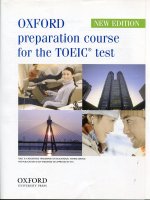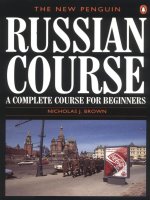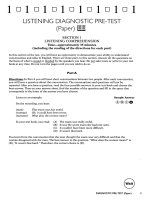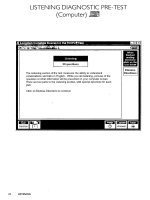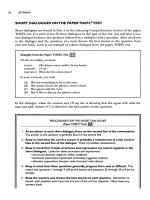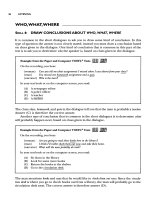Starter Teachers: A methodology course for the classroom
Bạn đang xem bản rút gọn của tài liệu. Xem và tải ngay bản đầy đủ của tài liệu tại đây (415.41 KB, 84 trang )
Starter Teachers
A methodology course
for the classroom
Blandine Akoue, Jean-Clair Nguemba Ndong,
Justine Okomo Allogo, Adrian Tennant
ISBN 978-0-86355-762-0
© British Council 2015 Design/E507
10 Spring Gardens
London SW1A 2BN, UK
www.britishcouncil.org
Authors
Blandine Akoue
Jean-Clair Nguemba Ndong
Justine Okomo Allogo
Adrian Tennant
Course Director
Adrian Tennant
Course Co-ordinator
Ibrahima Diallo
Proofreader
Marianne Tudor-Craig
Participants
Benin
Justin Djosse Assogba
Alain Lazare Ogoutegbe
Burkina Faso
Tassere Georges Zanga
Christian Paulin Zoure
Cameroon
Emma Mojoko Evele
Florence Aka Muluh
Frinwie Tamenang Ita épse Ndifon
Cote d’Ivoire
Vierge Bai
Emmanuel Aliefe Ble
Kouamé Raymond Cézer Kouassi
Gabon
Blandine Akoue
Justine Okomo Allogo
Bernard Bouassa
Charles Divingou
Christine N’no Engwang
Jean Pierre Ondo
Pélagie Essimengane
Pascal Nzoghe Essone
Raymond Patrice Ngama Eyi
Serge Alain Ignoumba
Alain Mihindou
Honorine Manomba épouse Mounguengui
Dieudonné Afane Nang
Jean-Clair Nguemba Ndong
Jean-Félix Obame Ndong
Laurent Nguimbi
Rachel Mboumba Mboumba épouse Ntahtangiye
Henriette Ngningone Obame
Edouard Poundou
Jean-Marie Ella Ovono
Mali
Sitan Diakite
Youssouf Magassouba
Senegal
Aminata Lo
Babou Casse
Togo
Sabankilie Darpak Sougue
Contents
Introduction...........................................................................................................................2
How to use this book...........................................................................................................3
Unit 1: How to train starter teachers..............................................................................7
Unit 2: Key issues in classroom observation and understanding needs..........13
Unit 3: Large classes and minimal resources............................................................19
Unit 4: Roles of a teacher and motivation of learners........................................... 27
Unit 5: Pair and group work............................................................................................ 35
Unit 6: Developing the four skills...................................................................................41
Unit 7: Teaching vocabulary and grammar................................................................47
Unit 8: Dealing with mistakes......................................................................................... 59
Unit 9: Assessment........................................................................................................... 65
Unit 10: Supporting starter teachers –
lesson planning and managing the classroom..........................................................71
Appendix: Bibliography................................................................................................... 79
Contents |
1
Introduction
This book is the by-product of a Hornby Regional School held in Libreville, Gabon
between 8 and 12 September, 2014. Thirty-five participants from eight francophone
West and Central African countries attended a course and spent five days looking at
issues and ideas of how to train starter teachers. At the end of the course three
participants stayed on for a few days and, with the course director, Adrian Tennant,
they have written this book.
The objectives of the book are as follows:
■■
To provide trainers with ideas and materials to use with starter teachers.
■■
To help trainers throughout the region understand the needs of
starter teachers.
■■
To provide a resource that can be used for designing sessions and workshops
for both pre- and in-service training courses.
To begin with it is probably necessary for us to define what we mean by the term
starter teacher. The first thing to point out is that starter teachers are not just
teachers with no experience, but also include teachers who are already in the
classroom but have little or no formal training. In many of the countries in the
region up to 80 per cent of teachers in the classroom fall into this category, so
there is an obvious need to address this issue.
We hope that this book will be used as a resource by those who were lucky enough
to be able to attend the course and by many teachers and trainers in the region
who would have liked to have attended, but did not have the opportunity. The book
has been designed to be as practical as possible – explaining theory but making it
relevant to the classroom through examples, activities and tasks.
Disclaimer: Wherever possible the original source of an idea has been
acknowledged. However, over a career spanning more than 25 years, some of
these sources have been lost or blurred over time. All efforts have been made to
attribute ideas correctly and a debt of gratitude goes to the hundreds of teachers
and colleagues who I have had the opportunity to work with and, who in some way,
have contributed to this book.
Adrian Tennant
Libreville, Gabon. 16 September, 2014.
2
| Introduction
How to use this book
It is important to realise that this book does NOT contain everything a starter
teacher needs to know and be able to do. This is just a guide for you, the trainer,
to help you think about the needs of the teachers you work with.
Each unit covers a topic area that the authors feel is essential for starter teachers.
The units include tasks, explanations and notes for the trainers. We have tried to lay
out the chapters so that trainers can use each task to refresh their own ideas and
memories of key methodological issues relating to the classroom. However, the
tasks are also designed to be used with starter teachers. As a trainer you may want
to select a few tasks, base a workshop around one particular unit, or try to
construct an entire training programme based on the entire book. We hope that
the book proves a useful resource and provides you with a better understanding
of the areas that need to be covered by starter teachers.
How to use this book |
3
4
| How to use this book
Unit 1: How to train
starter teachers
6
| Unit 1: How to train starter teachers
Unit 1
How to train starter teachers
Introduction
Task 1 – Who are starter teachers?
■■
Write your definition of a starter teacher here:
As suggested in the introduction to the book, the term starter teacher is quite a
broad one and includes teachers just beginning their career, as well as those who
have been teaching for many years but missed out on initial formal training. It can
also include teachers who might change who they are teaching, or what they are
teaching. For example, a teacher who has ten years’ experience in secondary
school, but is starting a new job in primary school can be classified as a starter
teacher. Or, a teacher trained as a French teacher, but now asked to teach English,
may similarly be seen as a starter teacher. This does not mean they lack
experience, but the relevance and context is different. Even people entering the
profession with no experience of teaching themselves have some knowledge of
what it entails as they attended schools as learners. In other words, they were
exposed to teachers and may have picked up ideas and techniques from them.
Training starter teachers implies the need to address both skills and knowledge
(see task 4 in this unit). We must remember that just because they are starter
teachers does not mean they don’t have experience. After all, they have attended
school and probably also learned at least one other language.
As trainers we need to provide starter teachers with ideas that will help them
improve their teaching in a typically multilingual African classroom where learning
happens in a language other than the mother tongue and make it as effective as
possible. It is useful for them to know the difference between language acquisition
and language learning.
Unit 1: How to train starter teachers |
7
Acquisition is a subconscious process that leads to use of language in the same
way that we learn our first language. Learning, on the other hand, is a conscious
mental process. Where possible, teachers should be providing their learners with
environments where both can take place. One vital ingredient of this environment
is giving learners the opportunity to use the language for communication.
Task 2 – How do you learn a language?
■■
Answer these questions and, if possible, discuss your answers with
other teachers.
1. How many languages do you speak and how did you learn them?
2. Did you learn English in the same way as you learned the other languages?
3. What are the differences between learning a language naturally and learning it
in a classroom?
4. Is it possible to teach yourself a language successfully?
5. Do we all learn at the same rate? If not, why not?
6. What are the characteristics of a good language learner?
7. Why do some learners find it more difficult to learn a language than others?
Task 3 – Methods and approaches
There are lots of different methods and approaches to teaching, but no single one
is ‘the best’ or the ‘right way’. Some methods work for some people and not for
other people. The most important things to think about when you are deciding how
to teach are:
1. What is the purpose of learning English? (If the purpose is to communicate then
the method(s) you choose should facilitate this.)
2. What works in a particular context? (If an idea
is based on a particular context i.e. the UK, USA etc. then it might not work in a
different context i.e. Asia, Africa etc. unless it is modified.)
3. What suits the teacher and his/her style?
8
| Unit 1: How to train starter teachers
Task 4 – What a teacher needs
■■
Think about the skills and knowledge required by a teacher and complete the
following chart.
Work in groups and complete this chart. You will need to discuss your ideas
together.
Skills
Knowledge
Suggested answers:
Skills
Knowledge
Classroom management
About the language/subject
Time management
Methodology
Rapport
Of the learners and their background
Empathy
Of the culture (and educational culture)
Motivational skills
Syllabus/curriculum
Awareness of body language
How learners learn
Good listener
Learning styles
Technical skills
Unit 1: How to train starter teachers |
9
Conclusion
We must remember that learning how to teach …
■■
takes time.
■■
takes practice.
■■
is an ongoing process.
Teachers must be creative and flexible to make their classes lively and effective.
Including a variety of tasks and topics can be a source of real motivation for the
learners. It is also important to remember that you are teaching the learners, not
blindly following the book or materials. The focus should always be on learning and
lessons need to be adapted to cater for the needs of the learners that are there,
not some notional learner made up according to the curriculum or coursebook.
10
| Unit 1: How to train starter teachers
Unit 2: Key issues
in classroom
observation and
understanding needs
12
| Unit 2: Key issues in classroom observation and understanding needs
Unit 2
Key issues in classroom
observation and
understanding needs
Introduction
In order to fully understand the needs of the teachers we are working with, we
need to observe them teaching to get a clear idea of the areas they need to develop.
However, observation can be difficult as starter teachers often feel under pressure
when they are being observed.
The purpose of observations
Observations have three main purposes. They can be used as:
■■
A quality check.
■■
A tool for teacher development.
■■
A way of gathering information and classroom data.
How observations are conducted
Probably the biggest issue is not the purpose of the observation but the way in
which it is conducted. An observation, where an observer walks into a lesson, sits
at the back reading, leaves after 15 minutes and then later tells the teacher what
he or she thought, is clearly going to result in a negative reaction. This is simply
judging the teacher without any understanding of the aims of the lesson, the
learners or any of the other constraints. Here is a suggested model, which tries
to incorporate ‘good practice’ in each stage.
Pre-lesson
Observer and observee should meet up and discuss the purpose(s) of the
observation, the criteria used to judge whether the teaching is good and effective,
issues surrounding the particular class being observed, the aims of the lesson and
the plan, how long the observation will be, when and how the feedback will be
conducted and the intended outcomes of the observation. In other words,
wherever possible the criteria and the intended outcomes should be co-created.
When teachers have the opportunity to buy into these aspects of an observation,
the whole process takes on a far more positive focus.
Unit 2: Key issues in classroom observation and understanding needs |
13
During
Observers should note down observations in the form of questions wherever
possible. The main rationale behind this is that what you can observe in the
classroom is the action and not the thought process. Even when the lesson has
been discussed beforehand, there are many instances within a class when teachers
need to make decisions that cannot necessarily be planned in advance. Good
teachers will be flexible and adapt to the learners’ needs during a lesson rather
than mechanically following a pre-set plan. By writing their observations in the form
of questions, observers give themselves the opportunity to explore issues, clarify
what they have seen and ask further questions designed to get teachers to think
about and explore their teaching in light of the lesson just taught. Whatever the
overall purpose of the observation, this positive focus cannot be harmful.
One reason for using this technique is that many aspects of teaching are
unobservable. While things such as classroom layout, use of the board and even
the pace of the lesson can be observed, these are all fairly low inference factors –
they are measurable, or quantitative; many of the skills employed by teachers are
high inference and are fundamentally qualitative. Only through discussion can
these aspects be explored and thus the effectiveness of the teaching ‘measured’.
Post-lesson
It is also important to remember that before the lesson the observer and teacher
agreed the criteria to be used during the observation. It is therefore essential that
the observer uses the criteria and doesn’t introduce anything new or unexpected
into the post-lesson conversation.
Finally, if possible, the observer should tell the teacher something he or she liked or
learned during the lesson that he or she would like to incorporate into his or her
own teaching. In this situation it is quite likely that the teacher will respond to the
observer’s feedback more readily. This is not a trick; it is a genuine feeling that
there is something positive to be taken out of every lesson and observation.
Why don’t all observations follow a similar model?
The main reason is lack of time. An observation process such as the one outlined
above is time-consuming. However, if this lack of time results in observations such
as the one briefly mentioned in the opening paragraph of this article, then there is
little point in carrying them out. Not only will such observations be uninformative,
but they will often lead to a distorted picture and are almost certain to increase the
negativity towards the process of observation, making it harder to get a true
reflection of what is happening in the classroom.
Based on an article: Key issues in classroom observation (see bibliography).
14
| Unit 2: Key issues in classroom observation and understanding needs
Task 1 – Questions to ask before the observation
We have talked about the need for the observer and the observee to meet before
the lesson to discuss the criteria for the observation so that it becomes more
focussed. What questions could you ask the teacher you are going to observe?
■■
Write three or four questions here:
1.
2.
3.
4.
■■
Now compare your questions to the ones suggested here:
1. What are your objectives for the lesson?
2. What will you do to make the lesson lively?
3. How will you try to involve the learners?
4. What do you expect the learners to do?
Task 2 – After the observation
■■
What questions can you ask the teacher (observee) after the lesson? Write your
ideas here:
1.
2.
3.
■■
Now compare your questions to the ones suggested here:
1. Do you think you have achieved your objectives? Explain why.
2. What are the positive aspects of your lesson?
3. What training would you like to help you improve your teaching?
Conclusion
Remember, each lesson is unique. A teacher has to bear in mind that he or she
must play different roles depending on the stage of the lesson etc. to make the
teaching successful (see Unit 4: Roles of a teacher and motivation).
Unit 2: Key issues in classroom observation and understanding needs |
15
16
| Unit 2: Key issues in classroom observation and understanding needs
Unit 3: Large classes
and minimal resources
18
| Unit 3: Large classes and minimal resources
Unit 3
Large classes and minimal
resources
Introduction
Large classes are a reality in all the countries represented by the teachers who
attended the Hornby School, as well as in many other parts of the world. Classes in
excess of 60 learners are not uncommon and present a challenge for most starter
teachers. However, there are many positives to large classes: they are dynamic and
with so many learners there are lots of opportunities for working together,
comparing, sharing and discussing ideas.
In addition to this, many teachers in West and Central Africa (as well as in many other
places around the world) face the challenge of a lack of resources. However, in the
same way that the issues of large classes can be overcome, teachers working in
contexts with minimal resources can be more creative and resourceful, taking
advantage of the surrounding environment to provide interesting and relevant
lessons for their learners.
Task 1 – Benefits and challenges
■■
Complete the following chart with the phrases in the box. Then compare and
discuss your answers in groups.
Benefits
Challenges
Classroom management is difficult
Providing for individual learning styles
Lots of interaction
Not boring
Quiet learners hide
Learners can learn from each other
Teachers feel out of control
Teachers learn to be creative
Too much marking
Variety
Unit 3: Large classes and minimal resources |
19
Suggested answers:
Benefits
Challenges
Lots of interaction
Classroom management is difficult
Not boring
Providing for individual learning styles
Learners can learn from each other
Quiet learners hide
Teachers learn to be creative
Teachers feel out of control
Variety
Too much marking
Task 2 – There’s always a solution
■■
The words below are suggested solutions for overcoming some of
the challenges in large classes, but the letters have been jumbled up.
The task is to unjumble the letters to make the correct words.
a. taryive
b. caep
c. stirnete
d. intorablooacl
e. sooslipantianer
f. ihoecc
g. sinetour
h. volinving
Suggested answers:
a. variety
b. pace
c. interest
d. collaboration
e. personalisation
f. choice
g. routines
h. involving
■■
Here are a few activities that require little in the way of materials or preparation
and can be used effectively in large classes.
Word tennis
1. Brainstorm how tennis is scored.
2. Elicit a list of categories e.g. colours, animals, buildings, jobs, family members,
clothes, sports.
3. Learners work in pairs.
4. They choose a category.
20
| Unit 3: Large classes and minimal resources
5. Learner A says a colour e.g. black.
6. Then learner B says a colour.
7. This continues until one player can’t continue (time limits can be set i.e.
20 seconds).
8. The winning player gets the points e.g. 15 – Love and chooses the next category.
Invisible body
1. Make sure every learner has paper and pencil/pen.
2. Read out words connected to the body and students should write them in
the correct place on the page as if there was a picture of a body on the page.
3. Put learners in pairs to compare and discuss.
Variation: names of countries/map; rooms/house; furniture/room; parts of a
car/car etc.
Board punctuation
1. Write up a short text (can be from a coursebook) on the board but leave
out punctuation, capital letters etc.
2. Students take turns coming up to the board and correcting the text.
Where do you live?
1. Ask a learner the question: Where do you live?
2. They must give an answer.
3. Now ask another learner – they must give a different answer.
4. Continue with each learner giving a new answer i.e. In Pakistan. At home.
With my parents. In a flat. In a small town. etc.
Be someone else
1. Ask for a volunteer to sit on a chair at the front of the class.
2. Tell them you will ask four personal questions and you want them to answer
the questions truthfully: Name? Age? Job? From?
3. Now tell them you’ll ask the same questions but they should use their
imaginations when they answer.
4. Then tell the rest of the class to ask the character questions.
Note: Adrian Tennant, course director, was first introduced to this activity
by Ken Wilson in a workshop at IATEFL Dublin in 2000.
Unit 3: Large classes and minimal resources |
21

